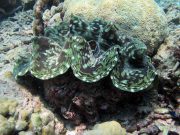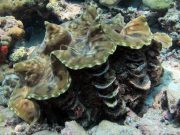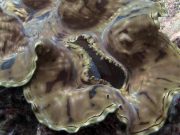Dykning med Kæmpe muslinger
Koh Lantas Marineliv | Tridacnidae
The giant clams are members of the Tridacninae family of large saltwater clams. The two-part shell usually has a wavy opening that never properly closes and faces the sunlight. De er et almindeligt syn på vores dykkerture på Koh Lanta.
Den hængslede side af skallen ligger nederst og er fastgjort til en hård overflade af en stor masse seje silketråde, der vokser fra mellemrummet mellem ventilerne nær hængslet. Nogle kæmpemuslinger graver sig ned i koraller, hvor det meste af skallen er skjult, og kun skallens åbning vender ud mod sollyset.
Kæmpemuslingerne lever på lavt vand ved koralrev og lever i symbiose med encellede fotosyntetiske alger (zooxanthellae) på samme måde som en koralpolyp. Zooxanthellaen lever inde i muslingen og producerer mad gennem fotosyntese, som den deler med muslingen.
Musslan vänder skalöppningen och kroppen mot solljuset för att maximera produktiviteten i sin 'algfarm'. Även om jättemusslor är mycket beroende av de symbiotiska algerna kan de fortfarande filtrera föda som andra musslor.
3 arter fundet på denne side:
Fluted Giant Clam
(Tridacna squamosa)
The Fluted Giant Clam is a medium to large clam, and is easily identified by the rows of leaf-like fluted edges on its shell called 'scutes'. Whilst not always easy to see small details, the scutes provide shelter for small invertebrates such as shrimp, crabs and other small clams.

Fluted Giant Clams @ Koh Bida
The mantle colour varies from greenish brown to yellowish tan to greenish blue or purple, with wavy lines, spots and blotches. There are two openings in the mantle to allow water to pass through, feeding and light to reach the zooxanthellae. It’s not uncommon to find crabs, small fish, shrimp and other animals living within the clam.
This giant clam grows to 40 cm in length and is often found in the open, or close to coral rubble areas, mostly in shallow water areas.
Giant Clam
(Tridacna gigas)

Giant Clam @ Koh Haa
The Giant Clam is the largest bivalve in the world. The shell is typically smooth, however other marine organisms attach themselves to the shell, which in the wild can then appear quite rough.
The shell has four vertical folds which create the ’wavy’ appearance of the mantle, which varies in colour from brown to tan to green through blue to purple. The mantle is fused except for two siphon holes, the longer hole to draw in water, and the smaller hole to expel water. The gills can be seen through the longer hole, and the shell is open during the day to allow sunlight to reach the zooxanthellae.
The Giant Clam grows to 130 cm and is usually found in flat shallow areas with plenty of sunlight. This is a slow growing species which is critically endangered in some areas due to over harvesting for food and shells.
Boring Giant Clam
(Tridacna crocea)
The Boring Giant Clam burrows deep into cracks in the reef and is usually only seen from the top, with only the mantle exposed.
The mantle colour varies from yellow to gold to tan to brown to green to blue to purple.

Boring Giant Clam @ Koh Bida
A row of ‘eyes’ can be seen along the margin of the mantle, and these provide rudimentary ‘vision’ allowing the clam to detect light, dark, and shadows from possible predators.
The clam chooses a location which is exposed to sunlight and attaches itself to the hard coral skeleton using strong silky threads (basal threads) from the hinge of the two shells (valves).

Boring Giant Clam @ Koh Haa
This clam is the smallest of all the giant clams, growing to 15 cm across and may form dense colonies of individuals.
Dykning med Kæmpe muslinger omkring Koh Lanta
Dykning og snorkelture
Hvis du gerne vil have chancen for at se Kæmpe muslinger på en af vores daglige dykkerture i højsæsonen fra Koh Lanta, så send os en e-mail til info@diveandrelax.com.
Deltag i vores speedbådsdykkerture i højsæsonen til nogle af Thailands bedste dykkersteder og nyd små grupper, korte rejsetider med fokus på god personlig service, sikkerhed og sjov.
Er du endnu ikke certificeret dykker? Lær at dykke på Koh Lanta med det 3-dages SSI Open Water Diver-kursus.
Book online og spar 10% på dykkerture og dykkerkurser på Koh Lanta.
Få mere at vide
Indo-Stillehavets havdyrsguider
- Allen, G., Steene, R., Humann, P., DeLoach, N. (2003) Reef Fish Identification, Tropical Pacific. Jacksonville, FL., USA: New World Publications, Inc., ISBN 1-878348-36-1.
- Humann, P., DeLoach, N., (2010) Reef Creature Identification, Tropical Pacific. Jacksonville, FL., USA: New World Publications Inc., ISBN 978-1-878348-44-9
- Debelius, H. (2013) Indian Ocean Reef Guide. Frankfurt, Germany: IKAN - Unterwasserarchiv, ISBN 978-3-939767-52-7.
- Debelius, H. (2004) Nudibranchs and Sea Snails, Indo-Pacific Field Guide. Frankfurt, Germany: IKAN - Unterwasserarchiv, ISBN 3-925919-51-1
- Erhardt, H., Knop, D. (2015) Corals Indo-Pacific Field Guide. Frankfurt, Germany: IKAN - Unterwasserarchiv, ISBN 3-925919-69-4.
- Veron J.E.N., Stafford-Smith M.G., Turak E. and DeVantier L.M. (2016). Corals of the World
Flere referencer om havets dyreliv og yderligere information


